#master of beasts
Explore tagged Tumblr posts
Text










horned and scorned
#hornsent#horns#elden ring#shadow of the erdtree#traditional#carmelart#creature#people#culture#sketches#doodles#bangles#sword#jewelry#robes#master of beasts#fan art#messmer the impaler#crusade#fire#crucible#furnace golem
82 notes
·
View notes
Text
Scythian gold: Scythian ancestral goddess, Sirens, and Scylla

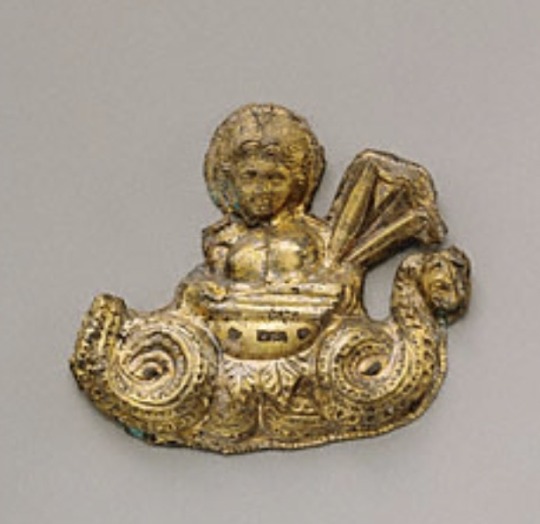

Etruscan pendants, images of Potnia Theron / Scythian ancestral goddess / sirens and Scylla.
Photo in mid left hand side is the Scythian ancestral goddess; photo in the mid right hand side is a siren. The two images on the bottom are Scylla.
I attempted to research these images until I had no more questions about who the figure is supposed to represent. Instead, the more information I found, the more questions I had. To save my sanity, I decided to be content in not knowing, and enjoy these lovely, ancient, Scythian-inspired Etruscan gold jewellery as is.
What I find fascinating about these pendants is how much they look like Starbuck’s siren: a woman, facing forward, grasping what look like her tails that are curving up towards her head.
What’s also interesting is that academics, researchers, and museums can’t seem to agree on what to label these.
In the Louvre in Paris, she’s called a Potnia Theron, despite not having any clear animals at her sides.
In the British Museum, London, she’s labeled a siren.
In a museum in Berlin, she’s simply called a goddess.
In an academic article that discusses this jewellery extensively, the author suggests she might be a siren, a vegetal goddess, or a potnia theron (lower case on purpose.)
I’m including two examples of Scylla, as they’re also gold jewellery, and show a likely connection between Etruscan snake-legged demons like Scylla and Typhon and the tendril-limbed Scythian ancestral goddess. (For reference: Sirens are bird-women in ancient art; Scylla has one or two fish tails. Usually.)
So, let’s just enjoy these different images that survived the centuries. Information is from the museums.

Louvre: Pontius Theron, Cerveteri. Department of Greek, Etruscan and Roman Antiquities. Catalog number: Bj 954. Part of the Campana Collection.

Sirens? Etruscan. 650-600BCE 7thC BC (Domenici 1995, 28)(Domenici 1995, 28) Found: Italy: Lazio: Cerveteri: Caere. British Museum.

Staatliche Museen, Berlin: 4th quarter of the 7th century BCE (2nd half of the 7th century BC -> 7th century BC -> Pendant (?) made of two equal pressed halves soldered together, depicting a standing woman (presumably a goddess) holding a plant stem in each hand; above: two seated lions with ram heads facing each other on their necks. The piece shows close parallels in its decoration to jewelry from the Tomba Regolini-Galassi in Caere (Cerveteri).
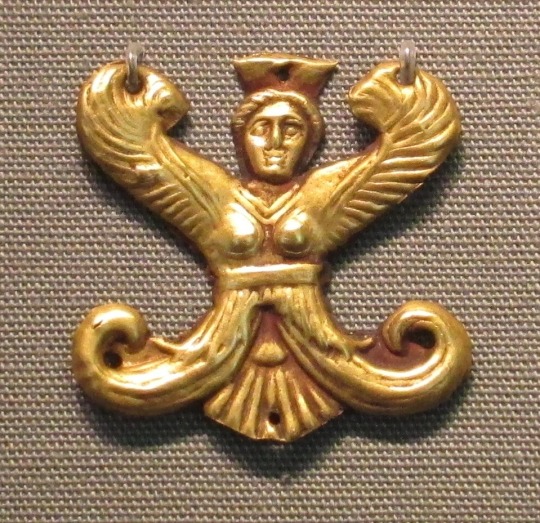

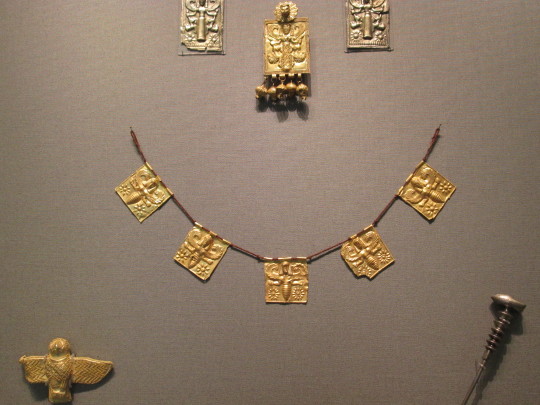
Altes Museum, Berlin: Gold jewelrey, Mistress of the Animals, possible Macedonia or southern Russia. 4-5th century. Altes Museum, Berlin.
Jewellery, 7th century BC. Kamiros/Rhodes, Melos, Dodona. Gold, 600-600 BC. Various depictions of “Mistress of the Animals.” My photos.

Scythian ancestral goddess. Gold plaques from the burial mound in Kul-Oba, near Kerch, Crimea, Ukraine. Image from Wikipedia.

Gold clasp consisting of two plaques, each embossed with a siren with four wings. Cultures/periods Etruscan Production date 490BC-470BC (early)5thC BC (Domenici 1995, 104)(Domenici 1995, 104
Excavated/Findspot: Chiusi Europe: Italy: Tuscany: Siena (province): Chiusi. British Museum.

Siren. Gold diadem, garnet, carnelian, sardonyx, 250-150 BCE, from Kerch / Ukraine. Staatliche Antikensammlungen, Munich. My photo.

Funeral wreath (Scylla and dolphins. Production 3rd century BCE. Museum fur Kunst & Gewerbe, Hamburg.

Two tailed Scylla, gold appliqué, Greek / South Italy, ca 300-275 BCE. At the Getty Villa Malibu.

4th century BCE., the Hermitage Museum in St. Petersburg, Russia.
From website info: Facing for a Horse's Frontlet
Gold; stamped. H. 41.4 cm. Scythian culture. 4th century BCE.
Tsymbalka Barrow, Dnieper Area, Zaporozhye Region, formerly the Taurida Province. Russia (now Ukraine)
Source of Entry: Imperial Archaeological Commission, St Petersburg. 1868.

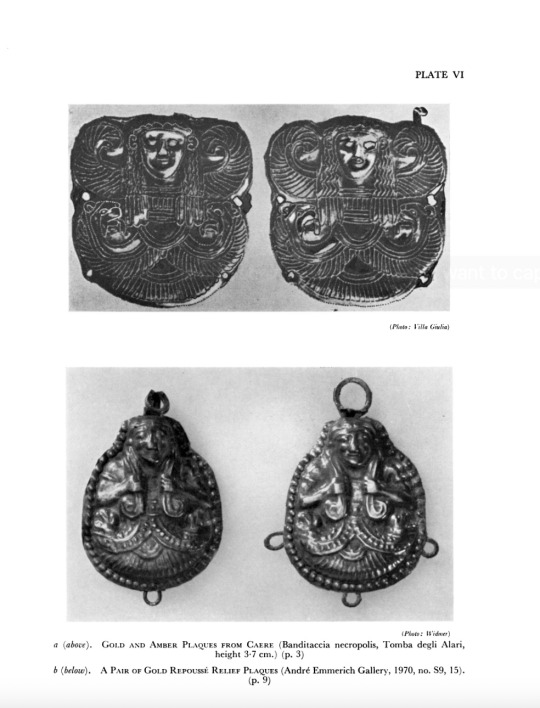
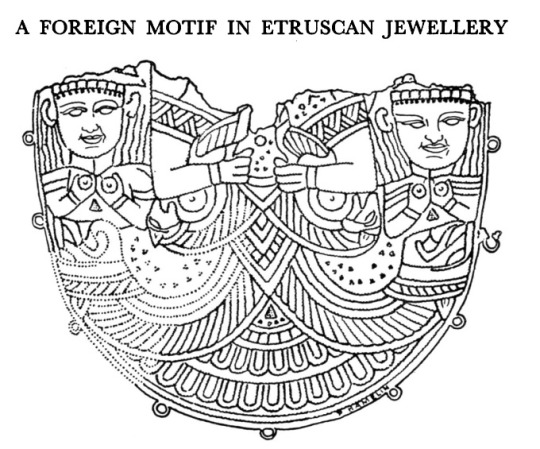
Images are screenshots from: Culican, William. “A Foreign Motif in Etruscan Jewellery.” Papers of the British School at Rome 39 (1971): 1–12. Web.
This research does confirm my theory: that ancient Scythian art inspired Etruscan art, giving us the two-tailed Scylla.
Update: I want to include this Hellenestic gold diadam here, from the British museum:

Gold diadam, Hellenistic. date 330BCE - 300BCE. Excavated/Findspot: Eretria (perhaps) Europe: Greece: Central Greece and Euboea: Évvoia (island): Eretria. I wrote about this more here.
What I’d love to find is a well researched, academic article titled “Bending the Icon: How the Near-East Potnia Theron’s Beasts Morphed into the Scythian Goddess's Snake Feet.” But that article hasn’t been written, and I don’t have access to library loans.
If you want to start a research deep dive of your own, here’s my main sources:
For a thorough analysis of these pendants, see:
Culican, William. “A Foreign Motif in Etruscan Jewellery.” Papers of the British School at Rome 39 (1971): 1–12. Via Jstor.
For a thorough analysis of this image in Scythian art, see:
Ustinova, Yulia. "Snake-Limbed and Tendril-Limbed Goddesses in the Art and Mythology of the
Mediterranean and Black Sea." Scythians and Greeks: Cultural Interaction in Scythia, Athens and the Early Roman Empire (Sixth Century B.C. - Fist Century A.D.). Exeter: University of Exeter Press, 2005.
See also:
Laws, Guitty Azatpay. "A Herodotean Echo in Pompeian Art?" American Journal of Archaeology 65, 1 (1961): 31-35. Via Jstor.
#mistress of animals#anguiped#etruscan#ancient greek art#greek mythology#scythian#scythian ancestral goddess#scythian gold#mistress of beasts#master of beasts#master of animals#potnia theron#two tailed siren#Scylla#two tailed scylla#etruscan myths
16 notes
·
View notes
Text
🔥 REBLOG If You Agree! 💬 COMMENT If You Have Thoughts! 🚀 FOLLOW If You Want More Unfiltered Truth!
Humans: The Ultimate Flex—Suck It, Animals and Aliens

Proof We’re the Crown Jewel of Evolution (and Why No One Else Even Comes Close)
Let’s not sugarcoat it: humans are the GOAT species. We’ve got opposable thumbs, complex languages, and the ability to feel existential dread at 2 a.m. over a dumb thing we said in 7th grade. No other species—or hypothetical alien race—has anything on us.
Think I’m exaggerating? Let me prove it with some brain and logic magic that’ll make you want to high-five yourself. Animals? Aliens? They can sit down and take notes.
1. Opposable Thumbs: The OG Superpower
First, let’s talk thumbs. Most animals are stuck with paws, hooves, or tentacles. But humans? We have these magical little appendages that let us write novels, build cities, and scroll endlessly through TikTok.
What Makes Us Special: Our thumbs can touch every other finger, giving us precision grip. That’s why we’re holding smartphones while chimps are still throwing poop.
Think about it: If aliens show up without thumbs, we’re dominating the handshake game.
2. Pattern Recognition: Brain Magic Level 100
Your brain is basically a biological Sherlock Holmes.
You See Faces in Clouds: That’s pareidolia—a fancy way of saying your brain loves patterns so much, it creates them even when they don’t exist.
You Predict the Future: Well, kind of. Your brain analyzes past experiences to anticipate what’s coming next. That’s why you can dodge a falling object or, more importantly, guess the next plot twist in The Bachelor.
Here's a Thought: Meanwhile, a lion can’t even tell that the waterhole is a trap until it’s too late.
3. Language: The Ultimate Mic Drop
Other animals communicate, sure. Dolphins click, bees dance, and your cat meows at you for food. But humans? We’re dropping sonnets, memes, and political debates.
Infinite Combinations: With 26 letters (or however many your language has), we can create endless words and ideas.
Aliens Could Never: If they don’t show up speaking Shakespeare, are they even worth the hype?
Humble Brag: We’re so good at language, we invented emojis to make up for not having enough ways to roast each other.

4. Memory: A Blessing and a Curse
Your brain doesn’t just store information—it rewrites and replays it like a director’s cut of your life.
No Other Animal Remembers Like This: Elephants may never forget, but they’re not lying awake at night cringing over awkward trunk waves.
Your Mind Is a Time Machine: You can travel to the past (memories) and imagine the future (dreams). Animals? They live in the moment like some kind of zen monks.
Fun Flex: Humans can create fictional worlds better than reality. Ever see a dolphin write Game of Thrones? Didn’t think so.
5. Problem-Solving: We Literally Break Physics for Fun
No other species solves problems like we do.
Fire: We didn’t just discover it; we harnessed it.
Tools: We’re the only species that looked at a stick and thought, “Let’s kill something big with this and eat it.”
Space Travel: Meanwhile, most animals don’t even understand up and down.
Alien Diss: If they haven’t figured out intergalactic travel yet, are they really that advanced?
6. Humor: The Ultimate Sign of Intelligence
Here’s the big one: humans laugh.
Why It’s Special: Humor requires recognizing absurdity, connecting ideas, and delivering them with timing.
No Competition: Animals might look funny, but they’re not cracking jokes.
Weird Thought: If aliens can’t meme, do they even matter?
7. Consciousness: The Unbeatable Crown
You’re aware of yourself. You can ask questions like, “Why am I here?” and then immediately distract yourself with cat videos.
No Other Species Has This Level of Meta: Animals act on instinct. You can reflect on your actions—and cringe at them later.
We are our Brain: Sure, consciousness makes us anxious, but at least we’re not stuck chewing cud and staring at nothing.

Humanity Wins, Every Time
So, yeah. Are humans perfect? No. But are we leagues ahead of anything else on Earth—or in the universe (so far)? Hell yes. Our brains, thumbs, and ability to crack dark jokes about it all make us the species to beat.
Animals? Cute, but predictable. Aliens? Call us when they invent sarcasm. Until then, humanity reigns supreme.
Think humans are awesome? (Of course you do—you’re one of us.) Follow The Most Humble Blog for more unapologetic takes and hilariously sharp insights into why we’re the best.
#power#dominance#human supremacy#apex predator#unstoppable#alpha mentality#no mercy#dark aesthetic#fearless#conqueror#strength#tame the wild#rule or be ruled#untamed#relentless#savage mindset#nature bows to man#master of beasts#survival of the fittest#rise above#warrior mindset#unbreakable#respect is earned#the strong survive#command respect#born to rule#dangerous aura#feral energy#look at me im the captain now#the world bends to the strong
133 notes
·
View notes
Text








#hairy#hairyman#arab men#arab muscle#biceps#flexing#bearded hunk#massive muscles#muscle beast#islamic alpha#arab superiority#arab supremacy#arab hot men#alpha master#arab bodybuilder#gay arabic#arab man#alpha muscle#islamic men worship#islamic superiority#islamic men#islam#islamic#arab men gym#beautiful arab man#arab gym#gym#arab master#arab men worshirp
664 notes
·
View notes
Note
FAVOREUTE ARTIST FOLLOWED ME HI IM BEAST ANCIENT HELLO
This is a very late response, but can I just say that never in my LIFE did I think anyone would call me their favorite artist??? The amount of support I’ve been getting recently is just so unreal because I used to really dislike my art and I still am very insecure about it. I think it just kinda proves artist blindness and how the creator really cannot comprehend what their art actually looks like

Also WHO IS EXCITED FOR ETERNAL SUGAR TO BEAT THE FUGK OUTNOF HOLLYBERRY⁉️⁉️⁉️⁉️⁉️⁉️⁉️⁉️⁉️WHOS READY FOR HOMEWRECKER EVIL YURI?!???

ok sorry anyway, tysm Ram and every1 else who has been liking my shit or has followed me it genuinely mean the world that my art can do something for you
#hollyberry crk#crk fandom#crk kingdom#crk design#crk fanart#crk art#cr kingdom#crk#crk hollyberry#hollyberry x pitaya dragon#hollyberry kingdom#hollyberry cookie#hollytaya#crk pitaya#crk pitaya dragon#pitaya dragon cookie#pitaya cookie#cookie run fandom#cookie run art#beast cookies#cookie run kingdom#cookie run kingdom fandom#cookie run fanart#cookie run tower of adventures#cookie run ovenbreak#totk master kohga#yiga clan#master kohga#sooga#aoc sooga
687 notes
·
View notes
Text
Okay but can we talk about how Carla Sunday said "It's The Beast" when responding to what the shadowy figure surrounding the TARDIS was.
And then... the voice playing Sutekh was actually "The Beast" in The Satan's Pit & The Impossible Planet.
Which was the vibes I was getting as soon as Harriet started being possessed and speaking.
God, I missed Doctor Who.
#dw#doctor who#dw spoilers#doctor who spoilers#empire of death#The Legend of Ruby Sunday#Okay but also does this mean that the creature in The Beast was actually Sutekh in S2?#Also why was there a tinge of the Master's theme playing when 'Susan' was starting to lose it.
2K notes
·
View notes
Text


Bug squashin’ with the boss
#Bloodborne#bloodborne valtr#bloodborne hunter#good hunter#valtr master of the league#valtr#tw: blood#tw; blood#embracing beast hood as a lil treat
476 notes
·
View notes
Text
Master of Animals & the Scythian ancestral goddess

When I first started researching the origins of the twin-tailed siren, I would chase down any and all mentions that might give me a clue to her origins, which sometimes led me down some deep dives into dead ends. Especially since the twin-tailed siren, the image of a woman holding her tails up to her ears, has never had a proper name, I never knew exactly which books or articles might hold an important clue.
Eventually, I decided to start conserving my time, and only researching historical images I thought were obvious, direct ancestors of the twin-tailed siren. For example, I came across a few mentions of the Scythian ancestral goddess or the snake-legged Scythian goddess.
I looked up the references, looked at images of her, and at the time, decided that although the images were very similar, this wasn’t actually the siren, OR significant enough to be related. Mistress and Master of Animal images are front-facing figures holding animals, and while the ones holding snakes look vaguely like the twi-tailed siren, I didn’t see the connection at first.
In retrospect, that was a mistake, and I could’ve saved myself a lot of time if I’d explored the connection between the Scythian ancestral goddess and the twin-tailed siren further.
(Especially as the Scythian images connect to art from ancient Iran and Mesopotamia, providing a fairly clear history of where the twin-tailed siren originated from. The twin-tailed siren was popularized on mainland Europe, so her move west makes geographical and cultural sense.)
One of several stumbling blocks I had was: some of the figures discussed with the Scythian ancestral goddess are male, and don’t seem like they have two tails. I’m going to go over several struggles I have with those images from Iran, such as the Luristan bronzes, and the Mistress and Master of Beasts images, and how they relate to the Scythian ones.
So we’re going to take a long look at both Luristan images and Scythian ones, focusing on male versions, or Master of Beast images. This is a line going back centuries: to ancient Assyria, Babylonia, and Persia (or southwestern Iran).
Let’s start by defining what “Master of Beasts” means, or Master of Animals. Keep in mind, Master of Animals doesn’t refer to a character from a specific cultural myth, but is a term used to describe a motif in ancient art. According to researchers reviewing the term in an article titled “The Master of Animals in Old World Iconography,” Master of Beasts is:
“an image that shows a central male figure (generally humanoid but at times winged or with animal parts) who stands upright and extends his arms out to either side of his body to hold animals/creatures.”
This is the definition that most academics agree on. A guy, facing us, holding animals in each of his hands. Of course, there’s discussion and debate around the name, and Chausidis’s magnificent research on images such as this prefers to use “idols with protomes.” And a “protome” is something that ends with an animal’s head. (This will be significant later.)
That’s the basic background. Now let’s take a look at the images of the Master of Beasts, and in particular, the motifs that are related to the Scythian ancestral goddess and later the twin-tailed siren.

Three stamps showing ancient depictions of the Master of Beasts motif, British Museum. (One, two, three)
Some very early versions of this motif are in the British Museum, and three versions show a front-facing figure holding his arms out to grasp what look like snakes. Made in 5000 BC - 4000 BC, these are some of the earliest examples of Master of Beasts images.
A lovely version in gold, called the “Lord of Animals” by the British Museum, was made between 1850BC-1550BC in Crete or Aegina, Greece. While he’s holding two geese, a pair of snakes arches around him, giving us a visual link to the Master of Beasts images and the curling tails of the twin-tailed siren.

A number of fascinating images of the “Master of Beasts” motif are cataloged in “Luristan Standards” by Nikos Chausidis. This is an extremely in-depth look at the “Luristan Bronzes,” which are a collection of bronze weapons, ornaments, and figurines from 650-700 BCE found in that mountainous area. While Chausidis prefers the term “idols with protomes” to Master of Beasts or Master of Animals, these ancient images show another link to the sirens. Many of these images are men holding animal heads off to the side. If you look quickly, and given how symmetrical the images are, the animal’s necks could be mistaken for tails.
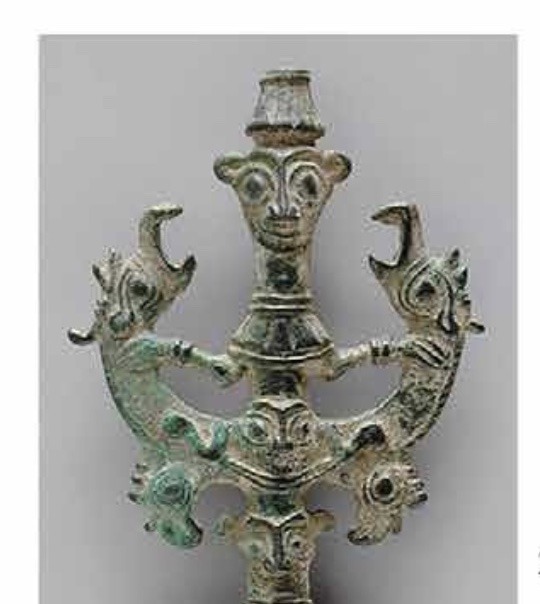
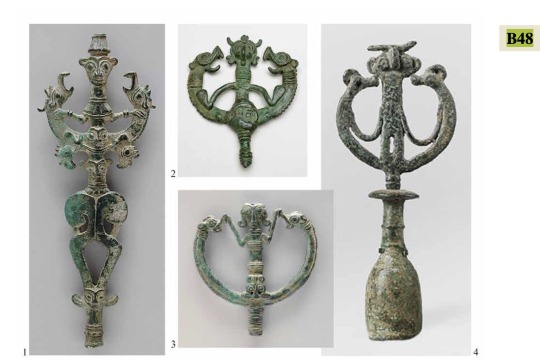
The Luristan bronzes are also the first real connection that the Master of Beasts have with the twin-tailed siren, as the oldest image of a twin-tailed siren is a Luristan bronze.
While I like to think that the Luristan figure is the great-grandmother of the siren of Starbucks fame, I know that’s probably not the case. There’s only two examples of twin-tailed mermaids from Luristan, and given the number of images of the Scythian ancestral goddess and Scylla with two tails, those are the likely source for the siren.
Next, I want to talk about the academic research that links Master of Beasts and the Scythian ancestral goddess. In a section called “Tendril-Limbed Creatures and Androgyny” in a book titled "Snake-Limbed and Tendril-Limbed Goddesses in the Art and Mythology of the Mediterranean and Black Sea,” several images of the Master of Beasts are discussed alongside the Scythian goddess.
I’ve already blogged about a few of these, like the figure on a capital in Salamais, Cyprus, Greece. The book does go into how the figure is either androgynous, or hermaphroditic, because the gender isn’t clear. This capital figure has both a beard and breasts.

There’s other examples that might be blurring gender lines. For example, a copy of a Roman throne from late 2nd BCE clearly has breasts, but is missing a head— making it hard to tell what gender the figure is.

From Isabella Stewart Gardner Museum. There's several copies of this, like the one in the Acroplis Museum in Greece. https://www.theacropolismuseum.gr/en/throne

However, other versions of this are clearly male. A marble relief currently in Berlin has a bearded, winged figure whose legs end in curling vines.


The photo is from blogspot, Roman Scribbler, who says it’s from San Gregorio Magno on Monte Celio. The info is from Möbius, Hans: “Eine dreiseitige Basis in Athen,”AM 51, pp 117-124,

A shirtless, bearded, winged man holds two griffins by the horns, making him look like a possible Master of Beasts image. He’s from the 3rd century BCE, in the New Hermitage Museum in St Petersburg.

Bringing this blog back to images connected with the Scythian ancestral goddess, we need to look at a bronze relief from Olynthus. Unfortunately, I’ve only managed to find drawings of it, which show a grumpy, winged figure holding two felines. While there’s no beard, the wings and animals make her look similar to figure in Berlin. This image from Olynthus is discussed in other articles looking at Master of Beast images, Scythian goddess images, and other deities with “tendril limbs” or curling vines for legs, such as "A Herodotean Echo in Pompeian Art?'
Like Artemis as the Mistress of Beasts or Potnia Theron, the core meaning of these images is the idea of influencing nature, whether it’s men dominating it as the Master of Beasts, or as a fertility goddess, like the Scythian ancestral goddess. The Mistress of Animals seems to prefer cats over snakes, geese, or other wild animals.

The final image I want to look at is the Scythian ancestral goddess on a horse bridle, with snakes for legs. She’s from the 4th century BCE, found in the Dnieper area, Zaporozhye Region, and is currently in Hermitage Museum in St. Petersburg. The style of her dress is similar to other images of the Scythian ancestral goddess, and her legs end in snake’s heads.


Putting this image side my side with Master of Beasts images, I finally under the connections-- both in the meaning of the images, as well as how they could have evolved. An image of a man holding snakes out as his side could, over time, become a woman with snakes for legs.
Sources.
Nikos Chausidis, Luristan standards - iconography, semiotics and purpose (English translation from Macedonian Igor Eftimovski). Skopje: Center for prehistoric research, 2022.
That definition I used:
Counts, Derek B., and Bettina Arnold. The Master of Animals in Old World Iconography. Archaeolingua, 2010.
Ustinova, Yulia. "Snake-Limbed and Tendril-Limbed Goddesses in the Art and Mythology of the
Mediterranean and Black Sea." Scythians and Greeks: Cultural Interaction in Scythia, Athens and the Early Roman Empire (Sixth Century B.C. - First Century A.D.). Exeter: University of Exeter Press, 2005.
Laws, Guitty Azatpay. "A Herodotean Echo in Pompeian Art?" American Journal of Archaeology 65, 1 (1961): 31-35.
DERWAEL, Stéphanie. “Half-Human Half-Vegetal Hybrids in Eastern Mosaics.” Journal of Mosaic Research 16 89–110. 2023.
Gisela M. A. Richter. “The Marble Throne on the Akropolis and Its Replicas.” American Journal of Archaeology, vol. 58, no. 4, 1954, pp. 271–76. JSTOR, https://doi.org/10.2307/500380
#twin-tailed siren#mistress of animals#two tailed mermaid#anguiped#master of animals#master of beasts#scythian#tendril limbed#ancient art
13 notes
·
View notes
Text
🔥 REBLOG If You Agree!
💬 COMMENT If You Have Thoughts!
🚀 FOLLOW If You Want More Unfiltered Truth!
The Brain’s Magic: How Your Mind Reads the ᵾᶰᴿᵋᴬᵭᵃᴮʟᵋ͟͟͞
Can You Still Call Yourself Human If You’re This F☰☰king Amazing?

Our brains are incredible biological machines that can decode the undecodable, make sense of chaos, and turn gibberish into understanding. You’ve probably seen those memes or tests where the letters in a sentence are jumbled, replaced with symbols, or entirely flipped. And yet, somehow, your mind calmly steps in and says, “I got this,” assembling the scrambled mess into meaning.
Why? Because your brain isn’t just functional—it’s damn near magical. But let’s get into the messy, hilarious, and downright extraordinary ways your brain proves every day why the universe needs you.
1. Your Brain, the Overachiever
First off, let’s acknowledge the absurdity of what your brain can do. You’re sitting there, possibly sleep-deprived, scrolling through social media while multitasking a mental to-do list. And yet, you see a sentence like this:
“Y0uR Br@!n 5T!lL r3c0gN!z3s p@77ern5 & m@k35 it m3@ningful.”
… and you just get it. You don’t need a translation guide. Your brain leaps over logic like a gymnast and lands perfectly on comprehension.
Reality is a stand-up comedian:
Your brain: a quantum computer that can decode unreadable text. Also your brain: forgets why you walked into the kitchen.
The same organ that turns chaos into understanding also Googles “symptoms of mild death” every time you get a headache.
2. Pattern Recognition: The Mind’s Hidden Flex
Here’s where things get spooky. Your brain isn’t just reading symbols—it’s recognizing patterns, filling gaps, and using context to solve puzzles in milliseconds. This isn’t something you learned; it’s baked into your DNA.
Fun Fact:
Studies show that 93% of adults can read a sentence where the first and last letters of every word are correct, but everything in between is scrambled. Your brain doesn’t even flinch.
Let’s put this into perspective: Computers need programmers, algorithms, and updates to achieve half the things your brain does on autopilot. Meanwhile, your mind’s out here solving puzzles like Sherlock Holmes at 3 AM with no coffee.
Your brain is that one friend who doesn’t study for the test but still scores higher than everyone else. Smug, but you love it anyway.

3. The Ultimate Biological Quantum Computer
Your brain isn’t just smart—it’s a show-off.
Neurons: You’ve got about 86 billion of them, and they’re firing off messages at speeds of up to 268 miles per hour. Faster than your Wi-Fi, honestly.
Processing Power: Your brain can handle around 10 quadrillion calculations per second. That’s the equivalent of a supercomputer with a personality (and occasional existential dread).
But here’s the kicker: your brain isn’t just processing facts—it’s synthesizing them into experiences. It’s why you can laugh at memes, cry during Toy Story 3, and somehow still navigate rush-hour traffic without committing vehicular manslaughter.
4. Can Machines Compete? Not a Chance
Artificial intelligence? Cute. Sure, machines can replicate some human functions, but your brain operates on a level AI can only dream of.
AI struggles with context. You? You can figure out when someone’s being sarcastic just by their tone.
Machines need explicit instructions. Your brain? It casually interprets nonsense like,“C@n u 3v3n r34d th!s?” …without breaking a sweat.
Imagine a robot trying to figure out your drunk texts. “Dinnrs @ 9, bt wtf hapen 2 keys?” Your brain decodes that in half a second. AI would implode.
5. Why This Matters: You’re Not an Accident
Let’s get serious for a second. Your ability to read scrambled text, pick up on patterns, and make sense of the seemingly senseless isn’t just a party trick. It’s evidence of how extraordinary you are.
Consider This: Your consciousness isn’t some random byproduct of biology. It’s a vital thread in the infinite web of existence. Every time you recognize patterns, connect ideas, or laugh at a well-timed meme, you’re proving that you’re not just surviving—you’re thriving.
ᵀ͡ʰᵉ ⱻ̷ᶰᴵᵛᴱʳˢᵉ ⱻ͜ᵉᵉᴅˢ ᵞᵒᵘ̷!
ᵞᴱˢ, ⱻ͞ᵐ ᵀʟᴋᴵⱭᴺᴳ ᴛᴼ ⱻⱭᴜ͡.!
You are a living, breathing node in the infinite network of reality. Even if you’ve doubted yourself in the past, even if the world tries to convince you that you’re ordinary, remember this:
Your mind isn’t just a tool—it’s proof that the universe is capable of creating something extraordinary. And every time you use it, you reaffirm your place in the fabric of existence.
Sure, your brain is powerful. But let’s not forget it’s also the same brain that makes you forget passwords and cry over fictional characters. Nobody’s perfect, but at least you're human, and that's close enough.
Love truth bombs like this? Follow The Most Humble Blog for more takes that roast nonsense and remind you why the universe can’t function without you.
#power#dominance#human supremacy#apex predator#unstoppable#alpha mentality#no mercy#dark aesthetic#fearless#conqueror#strength#tame the wild#rule or be ruled#untamed#relentless#savage mindset#nature bows to man#master of beasts#survival of the fittest#rise above#warrior mindset#unbreakable#respect is earned#the strong survive#command respect#born to rule#dangerous aura#feral energy#look at me im the captain now#the world bends to the strong
44 notes
·
View notes
Photo
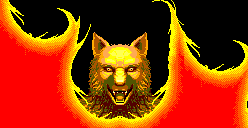
Wolf 'Altered Beast' SEGA Master System
276 notes
·
View notes
Text

#hairy#hairyman#arab men#arab muscle#biceps#flexing#bearded hunk#massive muscles#muscle beast#islamic alpha#arab gym#arab dom#arab master#arab hot men#alpha master#arab man#gay arabic#alpha muscle#islamic men worship#islamic superiority#arab alpha#arab superiority#arab supremacy#turkish man#turkish daddy
399 notes
·
View notes
Text
Choosing the Beast: Modern Folklore Heroines Embrace the Animal Husband

“I choose the bear.” The refrain rang out across the web, with many a woman nodding in agreement or at least understanding, and certain men huffing with indignant outrage. Just a meme, really, but did it speak to a deeper truth? Is it merely age-old mistrust of patriarchy talking, or a true desire for the beastly, the wild, the untame?
I’m no sociologist, of course, but I have noticed an emerging trend in fem-gaze media that seems to reflect this view. In movies like I Am Dragon (2015) and recent shows like My Lady Jane and The Acolyte, the heroine chooses the beast, loving her animal husband in his wild form rather than requiring him to transform back into a mundane man to earn her affection. This is such a departure from the typical folktale pattern that it’s difficult to even find an historic example where this occurs.
Commonly thought to reveal the desire to tame a dangerous mate in a patriarchal society, most animal husband tales (ATU 425a) feature a hero who ultimately transforms permanently into a human. This is viewed not only as freeing him from the maddening effect of his wild form, but also saving his bride from committing the sin of bestiality. In these tales, the animal mate’s transformation is necessary for the salvation of both.
Is the modern heroine then damned by choosing her husband’s beastly form? Or does she actually free them both from the yoke of patriarchal expectations?
Bathing: Discovering the Wild Masculine
The first motif that stands out in these modern screen examples is bathing. In animal spouse tales, there is often a dynamic of the hunter and the hunted, and thus a moment when the hunter comes upon their would-be lover unawares. Perhaps they find the animal spouse sleeping, or they cast a light on them unexpectedly, see them without their animal skin or disguise, and so on. And of course, they often come upon the lover at their bath.
There is an implied eroticism in this discovery, finding one’s quarry not only undressed, but also in the most private of activities. Water of course symbolizes fertility, but bathing is also purifying, symbolically washing away all that might make a mate undesirable. And this, perhaps, is the reason that historically this motif is used almost exclusively for animal brides, not animal husbands.
For the animal husband, he either actively chooses to reveal himself to the bride (perhaps on their wedding night), or she violently strips away his disguise, often armed with “flame and steel” like Psyche and her many avatars. Animal brides on the other hand are nearly always discovered at a body of water, bathing. The hunter will then capture her either by stealing her animal skin or cloak, or by placing his own clothing on her. What does it mean, then, when it is the husband who is discovered bathing in a body of water, held as an erotic object in the feminine gaze?

In The Acolyte, Osha follows Qimir to a pool where he slowly undresses, in full knowledge that she is watching. On the shore, she steals his lightsaber, just like the hunter who steals the animal skin, symbolically claiming him. When he emerges, Qimir dons new clothes, as if acknowledging that he is a different person than before he entered the water, almost purified in a way. Osha is forced to confront that there is more to the murderer in the mask than she realized.
Similarly, in My Lady Jane, our heroine goes looking for Guildford just before sunrise on their ill-fated wedding night, only to discover him bathing in the stables. The scene is gratuitously filmed from Jane’s (very horny) perspective, flipping the script on the countless scenes in screen history shot with the masculine gaze. Immediately after she discovers and confronts him, Guildford transforms against his will into a horse, and Jane realizes that he is an Ethian, a creature she has been taught is demonic and unnatural.

And in I Am Dragon, Mira makes several discoveries in quick succession: first, she deduces that Arman is actually the dragon. In the next moment, she slips from the island’s peak and falls, saved only when Arman transforms at the last moment and breaks her fall with his dragon form. The water begins to wash over his unconscious body, and at first Mira thinks that she will allow him to drown. But the sight of Arman in his human form after he rescued her, worried over by his animal familiar, stirs her to pity and she wraps him in a sail and drags him to safety. In this way, she clothes him, claiming him as her own.
Each of these heroines discovered a new aspect of her husband at the bath, finding him unexpectedly alluring, and ultimately choosing to begrudgingly claim him. Each animal husband tried to wash away his beastly form, to separate himself from the wild masculine. These men feel a sense of disassociation from a part of themselves, but now that their brides have discovered it, there will be no more hiding. Further, the bride now holds the power in the relationship, evidenced by how her husband needs her: Qimir needs Osha to be his apprentice, Guildford needs Jane to help him “break the curse,” and Arman needs Mira to heal him from his wounds.
Playing House: The Half-Husband
The second feature of these stories is a period of domesticity for the couple. For a brief time after the husband’s beastly nature is revealed, the lovers “play house” like children. While sexual tension is present, they typically do not consummate their union during this time, but instead cook, eat, rest, and care for one another. What’s more, they ignore or even attempt to actively destroy the husband’s animal form. They deny that this is part of him and therefore part of their relationship.
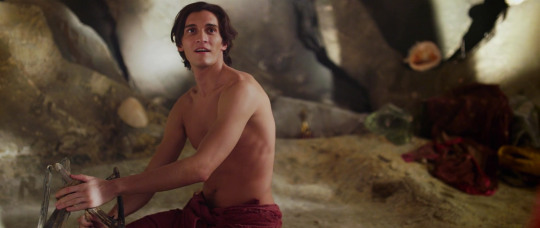
In I Am Dragon, Mira heals Arman, and wakes the next morning to find he has left food for her (dragonfruit, appropriately). Together they begin building a home out of shipwreck debris they find scattered around the island. A cheery montage shows them decorating a living space, choosing clothes, playing music, and dancing. But the specter of Arman’s monstrous form lurks on the edge of their idyllic life. Mira has nightmares, and tells Arman how much she fears “the dragon,” notably not referring to them as the same person. And eventually, it emerges that Mira has been planning to escape, rejecting Arman’s dragon form entirely.
After he sheds the helmet and robes of The Stranger, Qimir turns his attention to caring for Osha: he heals her, lets her sleep in his bed, provides clothes, and cooks for her. In turn, after some lightsaber-wielding, Osha becomes more comfortable in his home and accepts the food he offers, eventually even trying on his helmet. Later, they bicker amiably on their way to Brendok, like an old married couple on a road trip. When not facing down Jedi, Qimir leaves his menacing persona behind and transforms into an empathetic, protective, and alluring partner.

Jane Grey, meanwhile, finds herself using her honeymoon sequestered away in a private cottage to try to cure Guildford of his Ethianism. With her knowledge of medicine, she concocts various potions and magical cures, but none of them succeed. Guildford often checks in on her after these disappointments, making sure she’s getting enough sleep and taking care of herself. It’s also clear that they’ve been regularly dining together when Jane suddenly dashes off to rescue her friend. Guildford follows her and the two protect one another, followed by an almost-tryst. Even when they move into the palace, their day-to-day (or rather night-to-night) life is one of comfortable domesticity, although they continue to deny Guildford’s horse form.
In each of these cases (although less so in The Acolyte without Season 2 to continue the story), playing house can only last for so long while the husband’s animal nature is denied. There is a part of him that is suppressed, rejected, and this leads to him being incomplete, a half-husband. Each hero is unable or unwilling to accept and celebrate his whole self with his bride. Eventually, it is that denial that leads to a rift between the couple, which can only be healed not with the transformation of the husband, but with the embrace of his animal form.
Enforcing Patriarchy: The Rival
Each of these relationships exists in direct opposition to the dominant culture in the story: Arman as the Dragon is the literal enemy of Mira’s people, Qimir as Sith is the enemy of Osha’s Jedi masters, and in My Lady Jane, intermarriage between humans and Ethians is punishable by death. By choosing to stay with their animal husbands, even for a brief time, our heroines are openly defying the patriarchal norms of their societies. But no oppressive society is about to take that transgression lying down. In each story, a rival emerges to enforce the patriarchal order, kill the beastly husband, and retrieve the bride.

In I Am Dragon, Mira’s betrothed and descendent of the dragon-slayer, Igor, journeys to rescue her from the dragon. Over the course of the story, it becomes clear that Igor cares nothing for Mira herself, and merely feels entitled to her as his bride. Dragon-slaying is his heritage, so he must find her, kill the dragon, and take his place as the hero of his people. Even the marriage ceremony illustrates his ownership of her: he takes hold of a rope tied to her boat and reels her in, thus binding her to the patriarchal order. Contrast that to Arman, who offers her the power of flight, a symbol for freedom.
In Osha’s case, Qimir’s rival for her loyalty is clearly Master Sol, who wants to keep his former pupil dependent on him and the Jedi. Sol takes patronizing fatherliness to an extreme, constantly rescuing Osha rather than letting her stand for herself, teaching her to deny her feelings and instincts, and lying to her to “protect” her. The Jedi refuse to allow that there might be any other way to access the Force than their own, thus invading the home of the Brendok witches and ultimately orphaning the twins. Sol continues to press this dominance to the end, challenging Qimir and insisting to Osha that his own lies were justified.

In My Lady Jane, there are two rivals, both women. Lady Frances attempts throughout the show to dominate her daughters and crush their wills, forcing them into unwanted marriages, applying political pressure, and even counseling Jane to abandon Guildford to save herself. The other rival is Mary Tudor, who is determined not only to emulate her father’s violent, oppressive, and misogynistic reign, but to crush anyone she considers “unnatural” or who poses a threat to her rule. These characters stand as clear examples of how women can enforce patriarchy, too.
In each story, there is a moment when the rival briefly recaptures or “rescues” the bride from her beastly husband, bringing her to a moment of decision: will she stay within the bounds of patriarchy like a good little girl? Or will she make an act of defiance to choose her own path?
Marriage: Choosing the Beast
The bride’s choice will ultimately decide not only her fate, but that of her mate as well. As an independent character, the wild masculine is deeply wounded, separated from himself and thus from his bride. He longs to transform not into a greater, more whole person, but into a lesser, half-person. Alone, without the embrace of his anima, he cannot see the value of his beastly form. Instead of healing, he faces annihilation.
As a part of the bride’s psyche, the beastly husband represents her innermost desires, the truth of her heart, and a spirit freed from the expectations of her society. He is her animus, her missing wild masculine. If she transforms him into a man, then she will tame his wild nature, bringing him to heel under the boot of the patriarchy. Choosing the human form and rejecting the beast means rejecting her own psychological needs. It would be just another form of psychic dismemberment.

Fortunately and unusually, each of these modern brides chooses her beastly husband without demanding he transform. When Osha finally agrees to become Qimir’s apprentice, she takes his hand under the willow tree, clasping the newly-bled lightsaber between them. A few scenes later, this wedding imagery is repeated when they hold hands over the saber again, this time looking into a sunrise/set. Notably, at the moment they “marry” under the willow tree, Qimir is wearing his beastly helmet with rows of menacing, wolfish teeth. He has not come to the light side or shed his Dark Side persona, but Osha has embraced him anyway without fear. And while they might not both be healed (yet), they are more whole together than they were apart.
When her efforts to cure Guildford of his Ethianism repeatedly fail, Jane begins to suspect that his “condition” cannot be cured at all. But listening to her Ethian friends Susanna and Archer finally convinces her that the truth is Guildford doesn’t NEED to be healed - being an Ethian is who he is, and it’s nothing to fear. Unfortunately, Guildford still associates his beastly form with his mother’s death, so he is unable to accept it as Jane encourages, and flees. After a near-death experience, he uses his equine speed to return to the castle just as Jane is deposed and captured. As our heroes battle toward the end, Guildford comes to learn that there are many other proud Ethians, and that his family loves and accepts him in any form.
Still, he’s unable to transform at will, and when Mary captures him and sentences both husband and wife to death, it seems their story may end in tragedy. But as Guildford has been struggling to accept himself, Jane too has been battling with her own conscience. Does she renounce Guildford to save herself? Use her wits to kill the guard and escape? Bend to her mother’s manipulation? Jane confronts each temptation, and ultimately chooses to face death rather than betray Guildford or herself. But when her Ethian friends (the wild instinct) appear to disrupt the execution, our heroine seizes the opportunity to rescue Guildford. Unable to free him from the burning pyre, she confesses her love for him, and they kiss amid the flames.

Fire is often a herald of transformation, burning away illusions to reveal the truth. And when Jane and Guildford exchange their vows in this symbolic marriage ceremony, Guildford’s fears and illusions are finally burned away. Now that his bride has accepted his beastly form, he can accept it too, and so he at last transforms at will into a horse so that they can escape. Their story ends with them married and whole before the sunrise.
Among our modern heroines, Mira is the boldest in her embrace of the beastly husband. Offered yet again as a bride to Igor, she realizes that this is not what she wants, and casts off the tether from her boat. She declares “I love the Dragon!” using the name of her husband’s animal form rather than his human name. Then, she sings the song that will call the dragon to her, and he appears to carry her away again.
But their story is not over yet! Earlier in the story, Arman told Mira of how he loses control when in dragon form, and that dragons are compelled to reproduce by burning maidens to death and retrieving their offspring from the ashes. Returning to the island with her a second time, the dragon drops her on the altar and prepares to spew fire, but Mira lunges up and kisses him. This act of love, even when he is a monster, stuns the beastly husband. Again, Mira declares her love and kneels before him, saying she does not wish to be parted. We might expect the animal husband to transform in this moment, but instead he lays his fearsome head in her lap as a lover. Their story ends with a child and a flight in the sky, silhouetted by the sun just like the other couples.

Each bride, when confronted with the option to return to the patriarchal limits of her childhood, chose instead an act of love and acceptance for her wild masculine. This embrace helped the beastly husband to accept his whole self, and he is healed without having to cut off the wild parts of himself.
What Does It Mean?
Again, this story is so rare in world folklore that it’s difficult to even find examples. On fleeting occasions that the woman chooses an untransformed beast, it is presented as a cautionary tale. These women are framed as a danger to the community for their bestial impulses and abandonment of the social order, much like witches who were said to consort with the devil. It was certainly never presented as a happy ending, insofar as we can tell from written accounts.
So what does the emergence of this tale mean for our culture? I would argue that this is just the latest step in our ongoing reckoning with historic gender roles, as well as renegotiating with other forms of systemic oppression. People of all genders are pressured to reject a part of ourselves, cutting us off from our own truth and desires that run counter to the enforced social order. We must not challenge patriarchy, must not embrace different gender expressions, must not blur established hierarchies of power, must not find joy and power in our identities, and so on.
This enforced denial does tremendous damage to everyone caught in the system, and so through story, we dream our way to escape. We dream of embracing the dark, wild parts of ourselves, of flying free on a spaceship or a dragon or enchanted horseback, and of being totally loved for who we are.
It’s clear patriarchy is still fighting back against this emancipation of the wild feminine and wild masculine, given that both The Acolyte and My Lady Jane were canceled not long after their release. In the case of The Acolyte in particular, there was a sustained campaign from its announcement to harass and silence the creators. Demoralizing as this phenomenon may be, it’s important to remember WHO ultimately owns these stories:
“Fanfiction is a way of the culture repairing the damage done in a system where contemporary myths are owned by corporations instead of owned by the folk.
-Henry Jenkins, NYT 1997
Ah, an oldie-but-goodie. But Dr. Jenkins is right. Corporations may greenlight, film, release, and then cancel these stories, but ultimately they belong to the people. We take from these tales what speaks to us, leave what does not, and then retell them ourselves in fanfiction, in art inspired by the stories, and in lessons we pass on to our friends and families. If the embrace of the wild masculine speaks to you, let the story take root in your own life. Do you know someone who needs to be embraced, just as they are? Do you need to accept the parts of yourself that society tells you to hate? Do you want to be free, healed, and whole?
If so, then let these stories show you how, and tell more like them. Embrace the beast, and find your joy.
Sources:
Beauty and the Beast Tales From Around the World by Heidi Anne Heiner
In Search of the Swan Maiden: A Narrative on Folklore and Gender by Barbara Fass Leavy
And a relevant song for you, as a treat:
Women Who Run With the Wolves: Myths and Stories of the Wild Woman Archetype by Clarissa Pinkola Estés, Ph.D.
youtube
#monster husband#animal husband#atu 425a#the acolyte#oshamir#the acolyte meta#star wars#star wars meta#oshamir meta#osha x qimir#osha aniseya#qimir#master sol#my lady jane#lady jane grey#jane grey#guildford dudley#jane x guildford#janeford#on drakon#i am dragon#he's a dragon#i am dragon 2015#mira x arman#beauty and the beast#folk tales#fairy tales#anti patriarchy#save the acolyte#save my lady jane
754 notes
·
View notes
Text
✨️Masterlist 1✨️
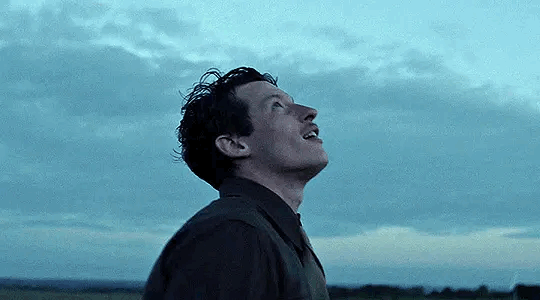
John Egan:
I'll come pick it up after / 2 / 3 / 4 / 5 / 6 / 7 / 8 / 9 / 10 / 11 / End /
Did you just kiss me?
Alright, bet!
Protect You
Back to black
Until you come back home / 2 /
Stop trying to feel everything
Inventor
Soft and prude
Small space
Run!
You want my jacket?
Kiss me before you leave
I hate / love you
Princess and the fool
I have a plan
You're like me, but better
New Girl
Never felt so...
Too Sweet
Chicken

Callum Turner:
Co- Stars / 2 / 3 / 4 / 5 / 6 / 7 / 8 / 9 / 10 / 11 / 12 / 13 / 14 / 15 / 16 / 17 / 18 /
Qué serà serà
Finals season

Joe Rantz:
Training / 2 /
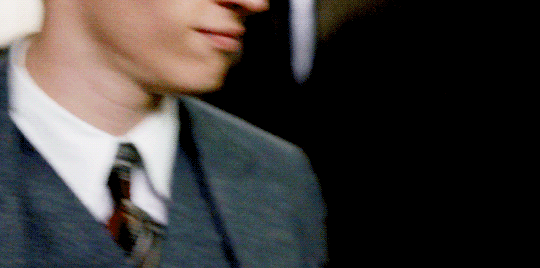
Theseus Scamander
Young, dumb in love
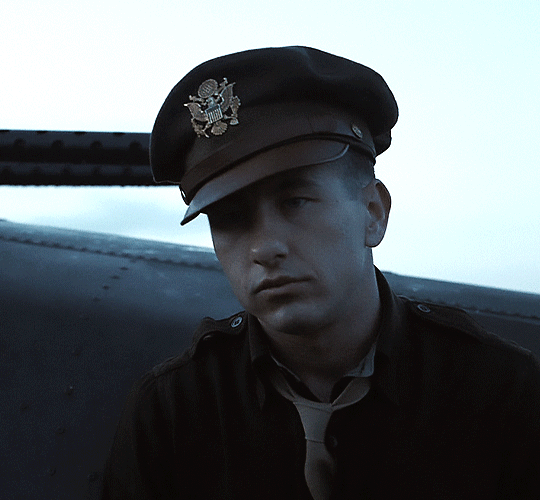
Curtis Biddick
Daylight
Your idiot?
You have to live

Gale Cleven
Told you she was real
Who did this to you?

Robert 'Rosie' Rosenthal
Therapist

Ronald Speirs
Disguise
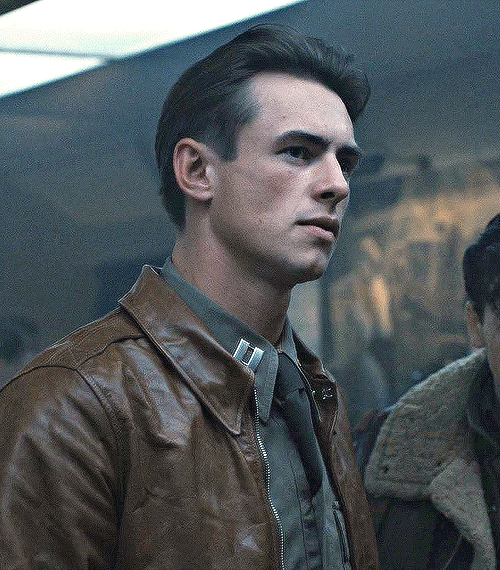
John Brady
Misunderstanding

Austin Butler
Fame / 2 / 3 / 4 /
Eugene Roe
Bastogne
#callum turner#callum turner x reader#callum turner imagine#john egan x reader#joe rantz x reader#major john egan#boys in the boat#master of the air imagine#master of the air#theseus scamander#fantastic beasts#rosie rosenthal#nate mann#band of brothers x reader#band of brothers imagine#band of brothers#eugene roe#ronald speirs#ronald speirs x reader#john brady#ben radcliffe#eugene roe x reader#eugene roe imagine
2K notes
·
View notes
Text
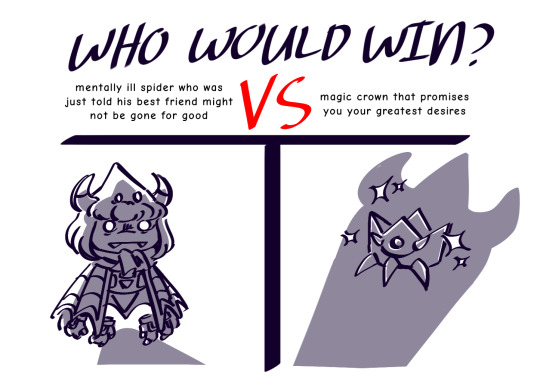



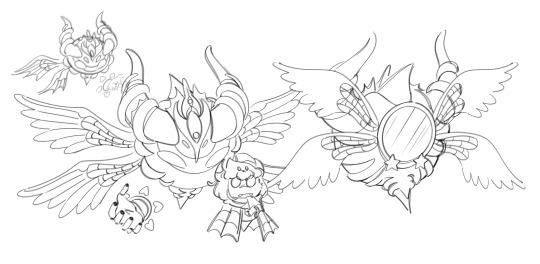


So, two years ago I finished up an arc on a Taranza Twitter parody account that revolved around a Master Crowned Taranza. I had never done anything this big before, and haven't since due to the massive burnout my unhealthy habits brought on whilst making it. Thanks to the recurring kirby brainrot, it has once again reappeared in my mind
Contemplating rewriting the arc entirely, but at least for now I'm definitely reworking some of these character designs. This shit was ROUGH.
And, hey, since a relatively small number of people followed me over from Twitter (much less from my parodies lmao) I thought it'd be neat to share some concepts here :)
If you have a twitter account and feel like convincing me to undergo this massive passion project you can like this here tweet to tell me to get off my ass
Apologies for the massive word post that isn't much more than an ad, but just in case this actually happens I don't wanna spoil much
Old designs under the cut for you to make fun of
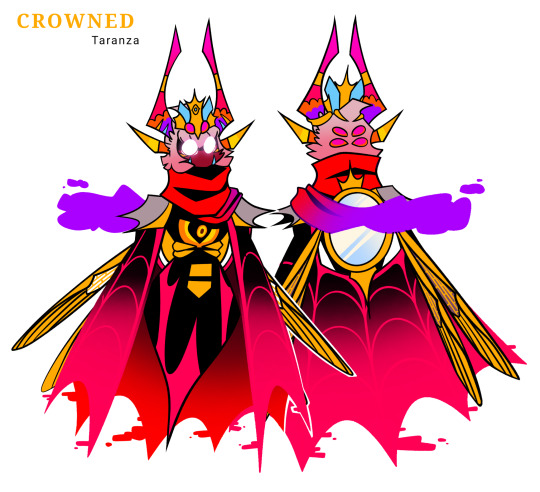
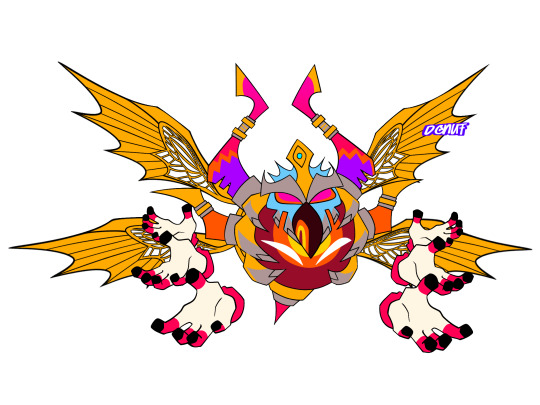
#donutarts#kirby#taranza#master crown#cranza#(my term of endearment for this beast)#magolor#elfilin#magoranza#canon to the arc!
821 notes
·
View notes
Text
You! Internalize that you do not always need to "improve your art/craft" now! It's great to learn and develop your skills, but you do not need to come from a place of hating where you are now! You certainly do not need to force yourself to improve if it is coming in between you and enjoying the things you do. Improvement for improvements sake does not have to be the only goal, nor the only one that "should matter"
You are allowed to have motifs, enjoyment, ameturism, and "less skill." Kill and devour the capitalist in your head that dictates that you must always improve for everybody else's sake and your "productivity."
#art#i've bought some knitting needles and i don't plan to be a goot knitter. i want to be a 'good' crocheter though#i think i denied myself learning to knit because it 'should mean' that i improve upon my skills every picosecond of the day#look - i want to be a good crocheter for MY sake. i want to be a mediocre knitter also for MY sake#i want to be like squidward - able to do so much art in a vast array of mediums without being the best#also squidward is a *good* artist and a mediocre clarinet player and that is GOOD#he's genuinely a very talented artist. his music is a different beast though <3#a jack of all trades is a master of none - but better is he than a master of one#gentle reminders
2K notes
·
View notes
Text

I’m juggling between art block and comms like a tennis ball help me humble Indian nurse beast eater..
#bloodborne#soulsborne#art#my art#the old hunters#fromsoftware#bloodborne art#bloodborne fanart#bloodborne oc#ocs#Valtr#beast eater valtr#valtr bloodborne#valtr master of the league#bloodborne valtr#league posting#beast eater#Bloodborne hunter
185 notes
·
View notes